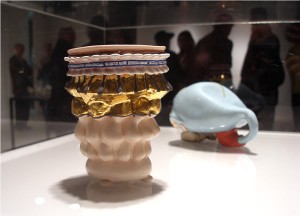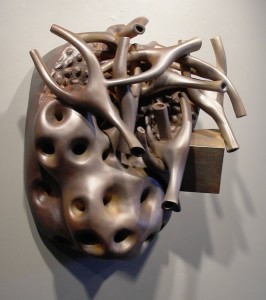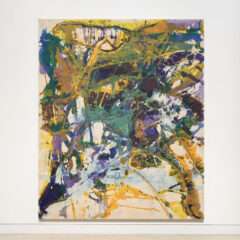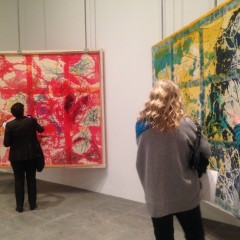For clay drama and dumplings head over to Locks Gallery. The mix of work by Betty Woodman on the second floor and Jun Kaneko, Kathy Butterly and Jill Bonovitzon the third is a treat. The small cup-like forms of Butterly and Bonovitz work well together because of their similarity in scale and shape. Both are adorned with flourishes reminiscent of George Ohr.

Bonovitz’ cups line up all in white along a wall of the gallery or group together on a black plinth, easily achieving the qualities of a crowd—homogeneous when seen together, deeply individual on closer inspection.

Butterly’s sculptures start off as vases or cups but their alterations and glazes liberate complex and whimsical personalities. The rippling clay falling off the side of Snake Charmer appears both sloppy and perfectionistic. Each piece has a sense of rhythm and flow enhanced by the combination of meticulous glazing and funky colors. Potted Wildflower is caught mid-spin like a whirling dervish; crown held high. A closer look reveals tiny fingers reaching up from the base, each with a dot of bright nail polish. In the same case Rock, Paper, Scissor looks at the other pieces; its body a little deflated with its tail/trunk tucked under itself in fear or shame.

The show is punctuated with six of Jun Kaneko’s semi-monolithic dangos. These range from two to three feet high which is large for hand built ceramics, but small compared to his record breaking works more than thirteen feet tall. In comparison these are really approachable dumplings.

Woodman’s work contains elements of all three of the others in the show as well as something more. For one thing there are the large paintings that occasionally serve as backdrops for her gestural vases. These paintings echo the colors and forms on the pots and also play with the flat surfaces that jut out from the clay as though each pot were growing a painting out of its shoulder. Her colors and brush strokes combine so many styles and traditions that it’s easy to play name that influence—Matisse, Italy, ancient Greece, Frank Stella, majolica, funk, and on and on. There were so many large pieces in the main room that it was a springtime feast. The Green Picture and the Yellow Vase reminded me of stage sets for plays staring vases.

The implied spaces in the paintings also act as a stand in for the kind of homes these sculptures belong in. Brightly-colored, ambiguously laid out rooms full of art and light. Woodman’s paintings resonate with the vases in part because they are all about façade. While our Romeo from the Yellow Vase appears to be fancy Italian white ware from the front, a look around the side shows that he is a darker character.

Locks Gallery, March 23- Apr 24, 2010
Syd Carpenter turns clay back into earth at Sande Webster
In the 1980’s architect Richard Westmacott conducted a study of African American farms and gardens, mapping out each farm in order to understand cultural relationships to building, growing, and earth. Syd Carpenter used Westmacott’s meticulous documentation as a starting point for her sculptural ceramics show A Place of Our Own at Sande Webster Gallery. These pieces couldn’t be more different from the work at Locks—while they have the medium of clay in common, all other aspects of the work vary from the tradition of brightly colored vessels. Carpenter’s sculptures are abstracted land portraits, telling a story about the daily lives lived in these particular spaces.

The clay medium undulates into walls and earth, weather and crops reflecting the gallery lights in a way that implies the harsh sun beating down on a shed roof. Many pieces use walls, fences, and land masses to create a sense of containment that sometimes reads as ownership and other times looks claustrophobic.

Carpenter interjects mundane objects like clothes pins, fence posts, and wish bones into the landscape magnifying their importance through scale. Standing among the 14 sculptures it seemed as though all aspects of farm life were there from belonging and communion with the earth to the feeling that everything is folding in and crushing you. While some seemed orderly and manageable, a piece like Inez Faust, with its undulating heart shape and pile of giant wishbones almost cantilevering off the wall, really communicates a feeling of precariousness, difficulty, and a the heavy burden of hope.

Definitely farm life as I know it.









